Urban Functional Zone Identification Based on Multimodal Data Fusion: A Case Study of Chongqing’s Central Urban Area
Abstract
1. Introduction
- 1.
- Integrating data from multiple sources, including image data, POI data, and OD data, the TriNet model extends traditional methods that primarily rely on image and POI data by exploring the possibility of extracting features from multi-source data to achieve a more comprehensive representation of the multidimensional characteristics of urban functions;
- 2.
- TriNet leverages deep learning techniques to extract high-level features and introduces a three-branch network architecture, which combines the ImgNet branch based on the EfficientNet-B4 model, the POINet branch based on kernel density estimation, and the TrajNet branch built on the Transformer architecture. This design enables the model to uncover nonlinear patterns within complex data and to capture the interactions among features derived from image, POI, and OD data, providing finer feature representations for UFZ classification;
- 3.
- By incorporating OD data, the model explicitly models the movement and dynamic relationships between land parcels. Compared to traditional methods that rely solely on static data, this approach better captures the dynamic features of UFZs, particularly in revealing the interaction patterns between residential, commercial, and commuting areas, offering a more comprehensive spatiotemporal perspective for UFZ delineation.
2. Materials and Methods
2.1. Materials
2.1.1. Study Area and Dataset
- 1.
- Images: The image data includes high-resolution RS imagery, as well as population, GDP, and nighttime light raster data. High-resolution RS imagery provides several advantages, such as fine spatial resolution, extensive coverage, and short acquisition periods, offering detailed and intuitive surface information that is essential for studying urban land use and functional zoning. This imagery allows for precise classification of land features and accurate spatial referencing, thereby enhancing the scientific rigor and accuracy of UFZ delineation. For the experiments in this study, the RS imagery for the central urban area of Chongqing was derived from Sentinel-2 imagery acquired on 26 August 2020, with less than 5% cloud cover and a spatial resolution of 10 m. Additionally, population, GDP, and nighttime light raster data from the same year were incorporated as auxiliary features to train the classification model. The population raster data were obtained from the WorldPop platform, released by Southampton University, with a 100 m resolution, representing the annual total population of China. GDP data are sourced from a publicly available dataset by Professor Zhao et al. [32], as published in their article. Nighttime light data are derived from the DMSP-OLS dataset by Wu et al. [33], which covers China from 1992 to 2023 and continues to be updated. All datasets have been corrected for accuracy and resampled to ensure consistency in both spatial and temporal resolution, aligning with the resolution of the RS data.
- 2.
- POI Data: POI data marks various locations related to human activities, such as restaurants, stores, and banks, and reflects the distribution of social functions, making it useful for creating UFZ maps. In this study, POI data for Chongqing were obtained from Amap (Gaode Maps), which legally collected and publicly released geographical information in 2020. The dataset includes 410,947 valid records with key fields such as name, coordinates, and category. It is a point-based dataset, where each POI represents a specific location (longitude, latitude) of a facility or service. The data covers 19 categories, including business and residential areas, dining services, healthcare, education, transportation, and government agencies, among others. The dataset contains 19 categories: business and residential areas, road ancillary facilities, dining services, vehicle maintenance, motorcycle services, companies and enterprises, shopping services, education, culture, and science, sports and leisure, transportation facilities, finance and insurance, accommodation services, tourist attractions, car sales, government agencies and social organizations, life services, healthcare, public utilities, and car services.
- 3.
- OD Data: OD data, as a dynamic crowd behavior data, plays an important supplementary role in multi-source data-based UFZ extraction research. Compared to static geographic information data such as land use vector data and RS imagery, OD data can reflect the activity patterns of crowds across different temporal and spatial dimensions, capturing the dynamic features of regional functions. This paper primarily utilizes OD data obtained from the processed public transport and subway card swipe data in Chongqing on 5 June 2021. The data are anonymized, with user card IDs omitted, and records the timestamp, departure and arrival coordinates, and mode of transport. The dataset includes approximately 270,000 OD records collected within a 24-h period on 5 June 2021, in Chongqing. The dynamic, continuous nature of OD data, along with its nearly full urban and rural spatial coverage and high possession rate, allows it to effectively reflect the overall spatiotemporal behavior patterns of people, uncovering dynamic urban functional features.
- 4.
- OSM Data: In this experiment, we generate samples based on the application of OSM data in UFZ classification, using 2020 OSM land use polygon vector data. The land use polygon vector data provided by the OSM platform holds significant research value. It contains spatial information on various land uses in the city, such as residential areas, commercial areas, industrial zones, green spaces, etc. In the study of UFZ extraction using multi-source data, OSM land use polygon data provides precise geometric boundaries and basic attribute information for the preliminary classification of functional zones. The decision to utilize OSM land use data was driven by the need to reduce the labor-intensive process of manually selecting sample areas for UFZ classification. While manually selected data offers high accuracy, it is resource-intensive, particularly in large-scale urban studies. OSM data provides a cost-effective alternative, offering readily available, albeit coarse, land use classifications. By using OSM data, we can efficiently generate a large sample dataset that serves as a preliminary classification, enabling the extraction of high-precision UFZs.
2.1.2. Data Preprocessing
- (1)
- Images data preprocessing
- (2)
- POI data preprocessing
- (3)
- OD data preprocessing
- (4)
- OSM data preprocessing
2.2. Methods
2.2.1. ImgNet: Spatial Feature Extraction from RS Images
2.2.2. POINet: Semantic Analysis of Urban Functions
2.2.3. TrajNet: Dynamic Spatiotemporal Modeling from OD Data
2.2.4. Feature Fusion and Classification
3. Results
3.1. TribNet Mapping Results
3.2. Classification Results of Other Models
3.2.1. Ablation Study of the TriNet Multi-Branch Model—Validation of the Irreducibility of Cross-Modal Feature Fusion
3.2.2. Heterogeneous Substitution of TriNet Branches—Validation of the Trade-Off Between Local Optimization and Global Performance
4. Discussion
4.1. Performance of the TriNet Model
4.2. Contribution of Each Branch to Model Performance
4.3. Advantages of TriNet over Existing Methods
4.4. Limitations and Future Directions
- Limitations of Data Quality
- (1)
- High-Resolution RS Data
- (2)
- Region of Interest (ROI) Data Quality
- (3)
- Accessibility of OD Data
- 2.
- Computational Complexity
5. Conclusions
Author Contributions
Funding
Data Availability Statement
Acknowledgments
Conflicts of Interest
References
- Liu, N. Classification of Urban Functional Zones Based on Multiple Data Sources. E3S Web Conf. 2024, 553, 04004. [Google Scholar] [CrossRef]
- Sun, Z.; Jiao, H.; Wu, H.; Peng, Z.; Liu, L. Block2vec: An approach for identifying urban functional regions by integrating sentence embedding model and points of interest. ISPRS Int. J. Geo-Inf. 2021, 10, 339. [Google Scholar] [CrossRef]
- Liu, S.; Su, L.; Guo, H.; Chen, Y. Identification of Urban Functional Areas and Governance Measures Based on Point of Interest Data: A Case Study of the Shenyang Railway Station Area in Shenyang City. Buildings 2022, 12, 1038. [Google Scholar] [CrossRef]
- Liu, B.; Deng, Y.; Li, M.; Yang, J.; Liu, T. Classification schemes and identification methods for urban functional zone: A Review of Recent Papers. Appl. Sci. 2021, 11, 9968. [Google Scholar] [CrossRef]
- Yin, J.; Dong, J.; Hamm, N.A.; Li, Z.; Wang, J.; Xing, H.; Fu, P. Integrating remote sensing and geospatial big data for urban land use mapping: A review. Int. J. Appl. Earth Obs. Geoinf. 2021, 103, 102514. [Google Scholar] [CrossRef]
- Liu, Z.; Wang, Y.; Zhang, C.; Liu, D. Quantitative Analysis of Spatial Heterogeneity and Driving Forces of the Urban Spatial Structure’s Development Level Based on Multi-Source Big Data: A Case Study of Beijing, China. Land 2023, 12, 1178. [Google Scholar] [CrossRef]
- Wei, B.; Su, G.; Liu, F. Dynamic assessment of spatiotemporal population distribution based on mobile phone data: A Case Study in Xining City, China. Int. J. Disaster Risk Sci. 2023, 14, 649–665. [Google Scholar] [CrossRef]
- Fan, R.; Feng, R.; Han, W.; Wang, L. Urban functional zone mapping with a bibranch neural network via fusing remote sensing and social sensing data. IEEE J. Sel. Top. Appl. Earth Obs. Remote Sens. 2021, 14, 11737–11749. [Google Scholar] [CrossRef]
- Du, S.; Zhang, X.; Lei, Y.; Huang, X.; Tu, W.; Liu, B.; Meng, Q.; Du, S. Mapping urban functional zones with remote sensing and geospatial big data: A systematic review. GIScience Remote Sens. 2024, 61, 2404900. [Google Scholar] [CrossRef]
- Wang, J.; Feng, C.-C.; Guo, Z. A novel graph-based framework for classifying urban functional zones with multisource data and human mobility patterns. Remote Sens. 2023, 15, 730. [Google Scholar] [CrossRef]
- Sanlang, S.; Cao, S.; Du, M.; Mo, Y.; Chen, Q.; He, W. Integrating aerial LiDAR and very-high-resolution images for urban functional zone mapping. Remote Sens. 2021, 13, 2573. [Google Scholar] [CrossRef]
- Li, Y.; Liu, C.; Li, Y. Identification of urban functional areas and their mixing degree using point of interest analyses. Land 2022, 11, 996. [Google Scholar] [CrossRef]
- Liu, B.; Deng, Y.; Li, X.; Li, M.; Jing, W.; Yang, J.; Chen, Z.; Liu, T. Sub-block urban function recognition with the integration of multi-source data. Sensors 2022, 22, 7862. [Google Scholar] [CrossRef]
- Chen, Y.; Yang, J.; Yang, R.; Xiao, X.; Xia, J. Contribution of urban functional zones to the spatial distribution of urban thermal environment. Build. Environ. 2022, 216, 109000. [Google Scholar] [CrossRef]
- Mo, Y.; Guo, Z.; Zhong, R.; Song, W.; Cao, S. Urban Functional Zone Classification Using Light-Detection-and-Ranging Point Clouds, Aerial Images, and Point-of-Interest Data. Remote Sens. 2024, 16, 386. [Google Scholar] [CrossRef]
- Wang, Z.; Ma, D.; Sun, D.; Zhang, J. Identification and analysis of urban functional area in Hangzhou based on OSM and POI data. PLoS ONE 2021, 16, e0251988. [Google Scholar] [CrossRef]
- Jing, C.; Hu, Y.; Zhang, H.; Du, M.; Xu, S.; Guo, X.; Jiang, J. Context-aware matrix factorization for the identification of urban functional regions with POI and taxi OD data. ISPRS Int. J. Geo-Inf. 2022, 11, 351. [Google Scholar] [CrossRef]
- Jing, Y.; Sun, R.; Chen, L. A method for identifying urban functional zones based on landscape types and human activities. Sustainability 2022, 14, 4130. [Google Scholar] [CrossRef]
- Sun, Z.; Li, P.; Wang, D.; Meng, Q.; Sun, Y.; Zhai, W. Recognizing Urban Functional Zones by GF-7 Satellite Stereo Imagery and POI Data. Appl. Sci. 2023, 13, 6300. [Google Scholar] [CrossRef]
- Chang, S.; Wang, Z.; Mao, D.; Liu, F.; Lai, L.; Yu, H. Identifying urban functional areas in China’s Changchun City from Sentinel-2 Images and social sensing data. Remote Sens. 2021, 13, 4512. [Google Scholar] [CrossRef]
- Yan, J.; Feng, P.; Jia, F.; Su, F.; Wang, J.; Wang, N. Identification of secondary functional areas and functional structure analysis based on multisource geographic data. Geocarto Int. 2023, 38, 2191995. [Google Scholar] [CrossRef]
- Huang, C.; Xiao, C.; Rong, L. Integrating point-of-interest density and spatial heterogeneity to identify urban functional areas. Remote Sens. 2022, 14, 4201. [Google Scholar] [CrossRef]
- Wang, J.; Gao, C.; Wang, M.; Zhang, Y. Identification of Urban Functional Areas and Urban Spatial Structure Analysis by Fusing Multi-Source Data Features: A Case Study of Zhengzhou, China. Sustainability 2023, 15, 6505. [Google Scholar] [CrossRef]
- Lu, W.; Qi, J.; Feng, H. Urban functional zone classification based on self-supervised learning: A case study in Beijing, China. Front. Environ. Sci. 2022, 10, 1010630. [Google Scholar] [CrossRef]
- Xie, L.; Feng, X.; Zhang, C.; Dong, Y.; Huang, J.; Liu, K. Identification of urban functional areas based on the multimodal deep learning fusion of high-resolution remote sensing images and Social Perception Data. Buildings 2022, 12, 556. [Google Scholar] [CrossRef]
- Zhao, W.; Li, M.; Wu, C.; Zhou, W.; Chu, G. Identifying urban functional regions from high-resolution satellite images using a context-aware segmentation network. Remote Sens. 2022, 14, 3996. [Google Scholar] [CrossRef]
- Lu, W.; Tao, C.; Li, H.; Qi, J.; Li, Y. A unified deep learning framework for urban functional zone extraction based on multi-source heterogeneous data. Remote Sens. Environ. 2022, 270, 112830. [Google Scholar] [CrossRef]
- Zhang, X.; Du, S. Geoscene Modeling and Analysis for Urban Functional Zones. The International Archives of the Photogrammetry. Remote Sens. Spat. Inf. Sci. 2022, 48, 91–96. [Google Scholar]
- Chen, J.; Peng, S.; Zhang, H.; Lin, S.; Zhao, W. Exploring Urban Functional Zones Based on Multi-Source Semantic Knowledge and Cross Modal Network. The International Archives of the Photogrammetry. Remote Sens. Spat. Inf. Sci. 2023, 48, 1337–1342. [Google Scholar]
- Yang, X.; Bo, S.; Zhang, Z. Classifying Urban Functional Zones Based on Modeling POIs by Deepwalk. Sustainability 2023, 15, 7995. [Google Scholar] [CrossRef]
- GB 50137-2011; Classification of Urban and Rural Land Use and Planning Standards of Development Land. China Architecture & Building Press: Beijing, China, 2011.
- Zhao, N.; Liu, Y.; Cao, G.; Samson, E.L.; Zhang, J. Forecasting China’s GDP at the pixel level using nighttime lights time series and population images. GIScience Remote Sens. 2017, 54, 407–425. [Google Scholar] [CrossRef]
- Wu, Y.; Shi, K.; Chen, Z.; Liu, S.; Chang, Z. Developing improved time-series DMSP-OLS-like data (1992–2019) in China by integrating DMSP-OLS and SNPP-VIIRS. IEEE Trans. Geosci. Remote Sens. 2021, 60, 1–14. [Google Scholar] [CrossRef]
- Tan, M.; Le, Q.V. EfficientNet: Rethinking Model Scaling for Convolutional Neural Networks. In Proceedings of the 36th International Conference on Machine Learning, Long Beach, CA, USA, 9–15 June 2019. [Google Scholar]
- Li, P.; Liu, J.; Luo, A.; Wang, Y.; Zhu, J.; Xu, S. Deep learning method for Chinese multisource point of interest matching. Comput. Environ. Urban Syst. 2022, 96, 101821. [Google Scholar] [CrossRef]
- Alonso, F.D.; Lozano, F.J.; García-Ordás, M.T. Convolutional neural networks for accurate identification of mining remains from UAV-derived images. Appl. Intell. 2023, 53, 30469–30481. [Google Scholar] [CrossRef]
- Lan, W.; He, G.; Liu, M.; Chen, Q.; Cao, J.; Peng, W. Transformer-based single-cell language model: A survey. Big Data Min. Anal. 2024, 7, 1169–1186. [Google Scholar] [CrossRef]
- Wang, Z.; Liang, Y.; He, Y.; Cui, Y.; Zhang, X. Refined Land Use Classification for Urban Core Area from Remote Sensing Imagery by the EfficientNetV2 Model. Appl. Sci. 2024, 14, 7235. [Google Scholar] [CrossRef]
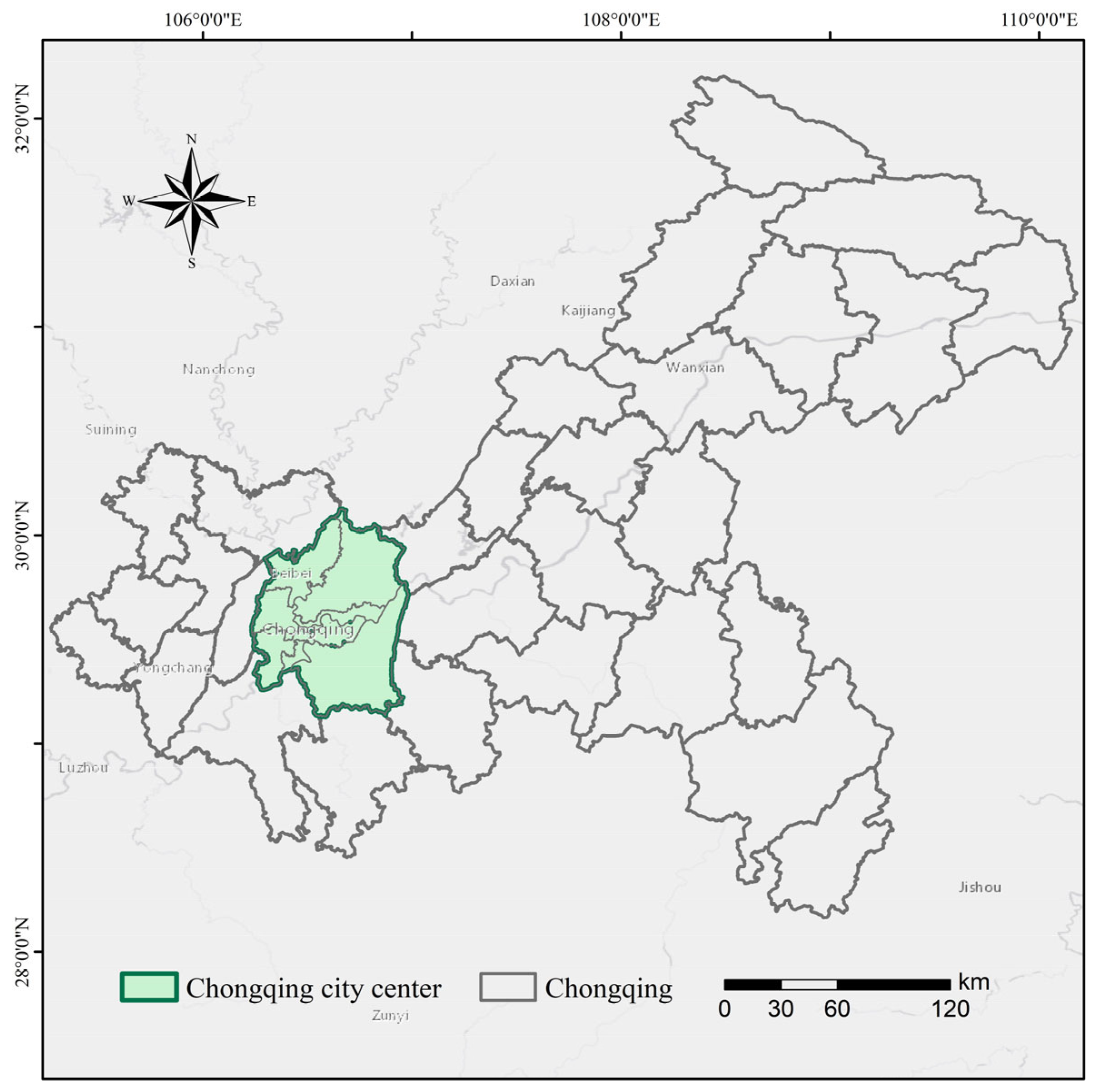

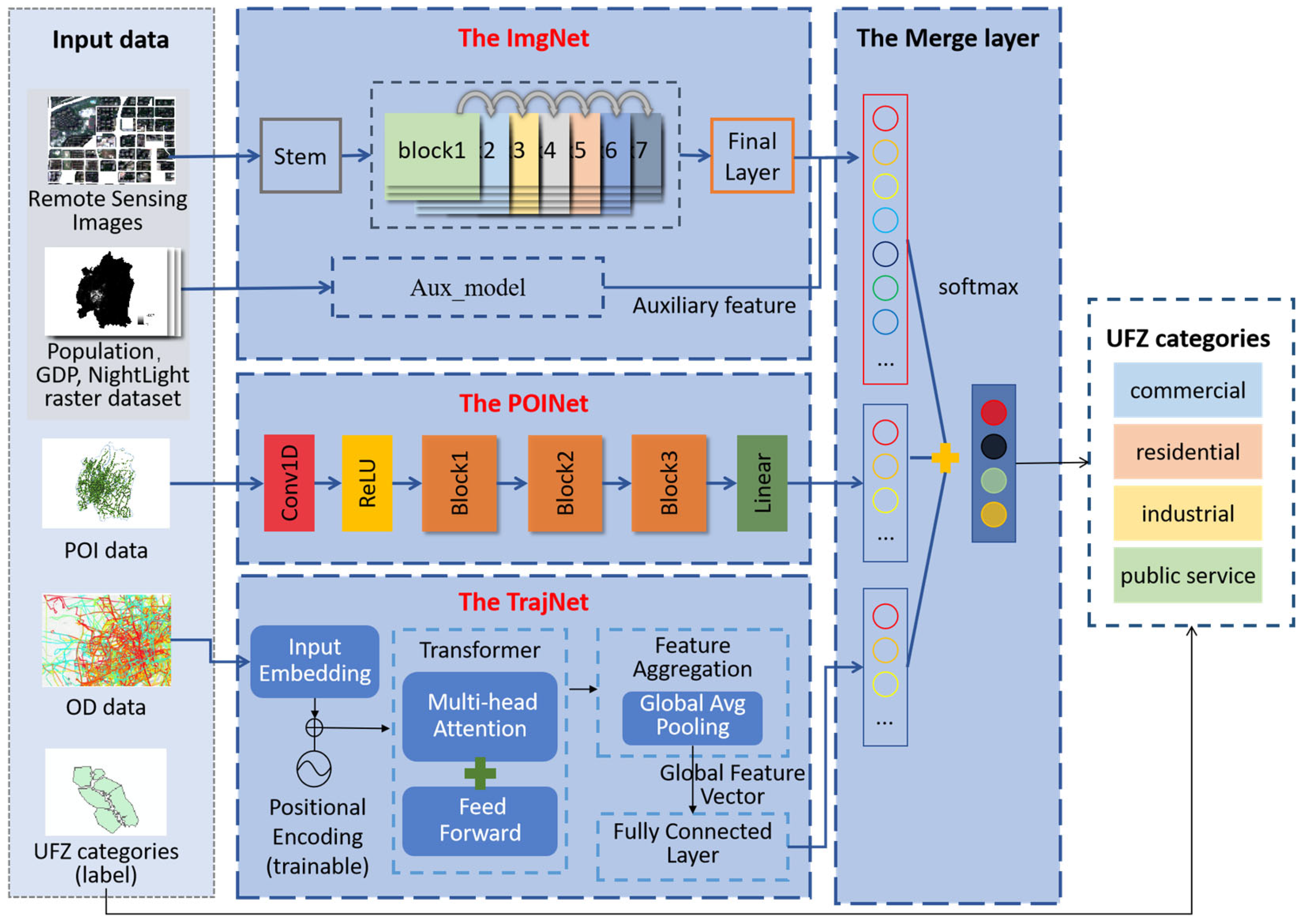
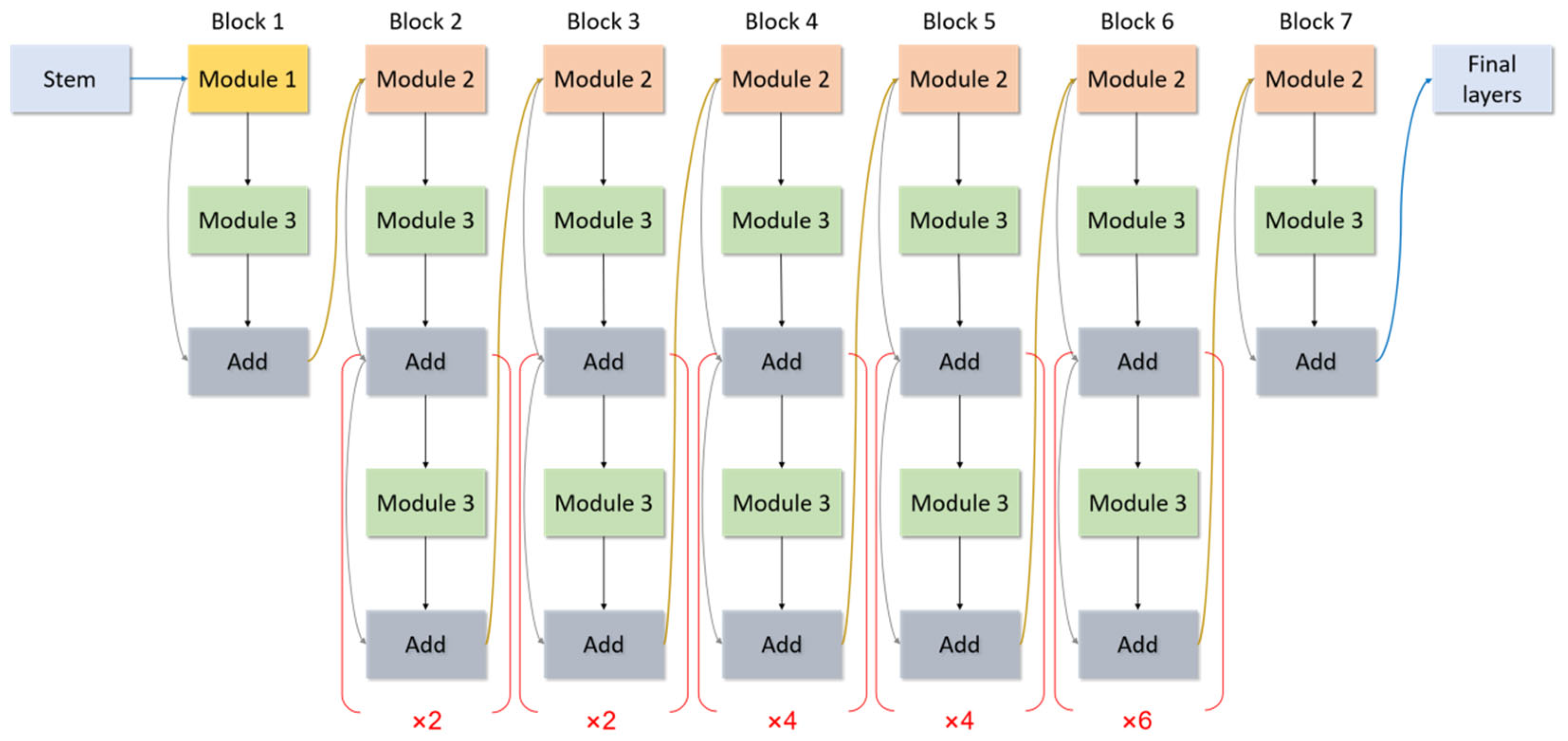

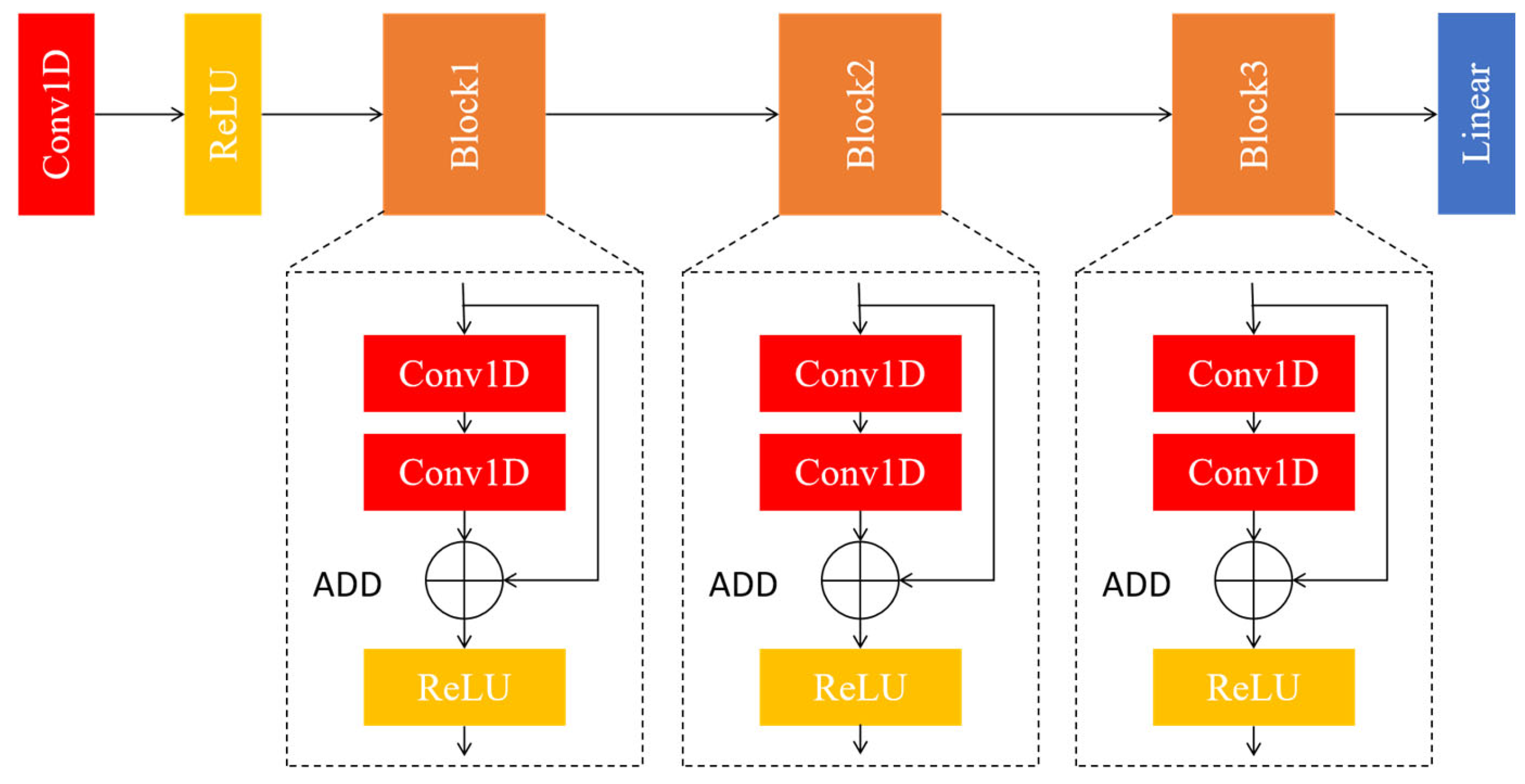
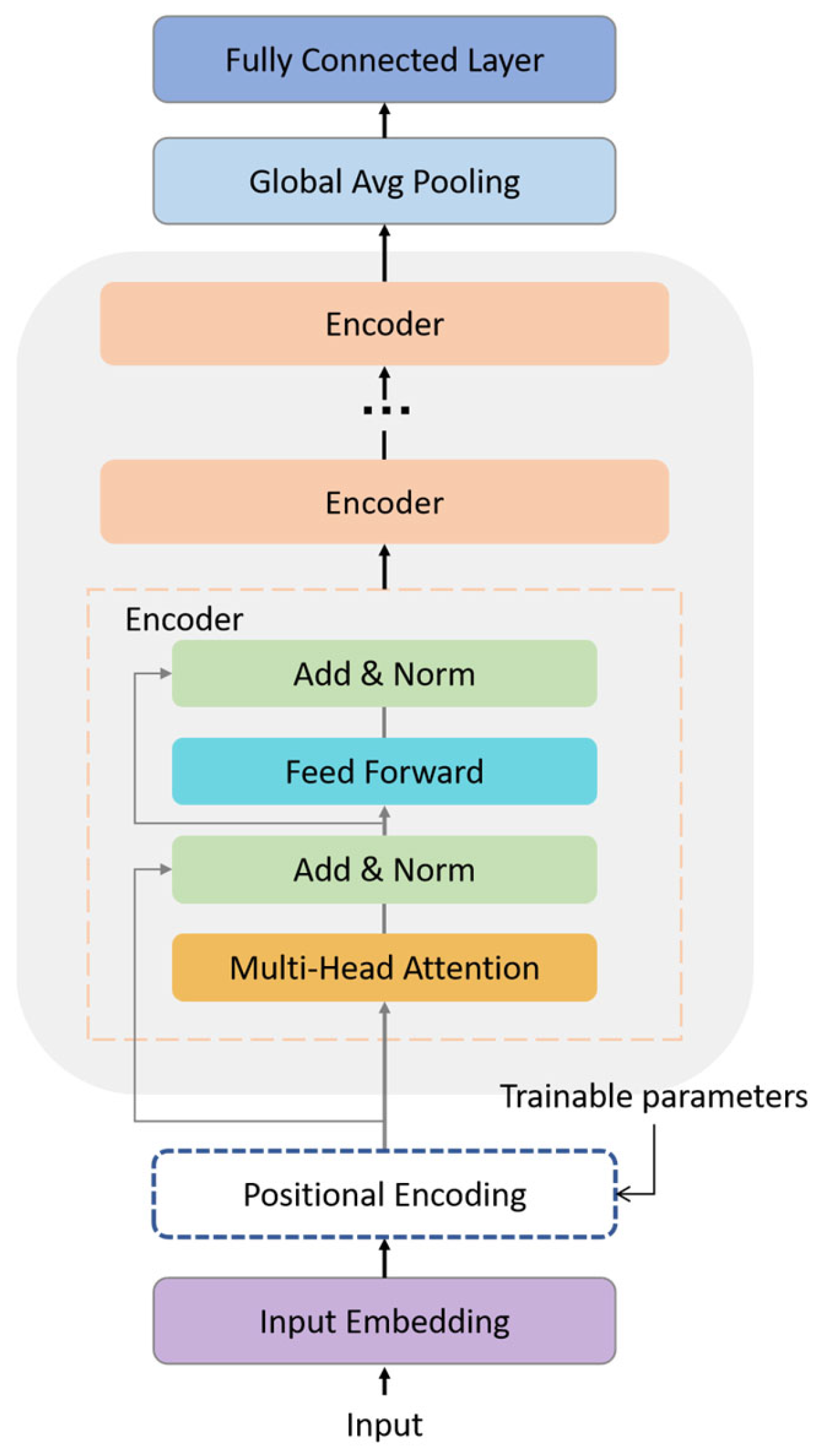
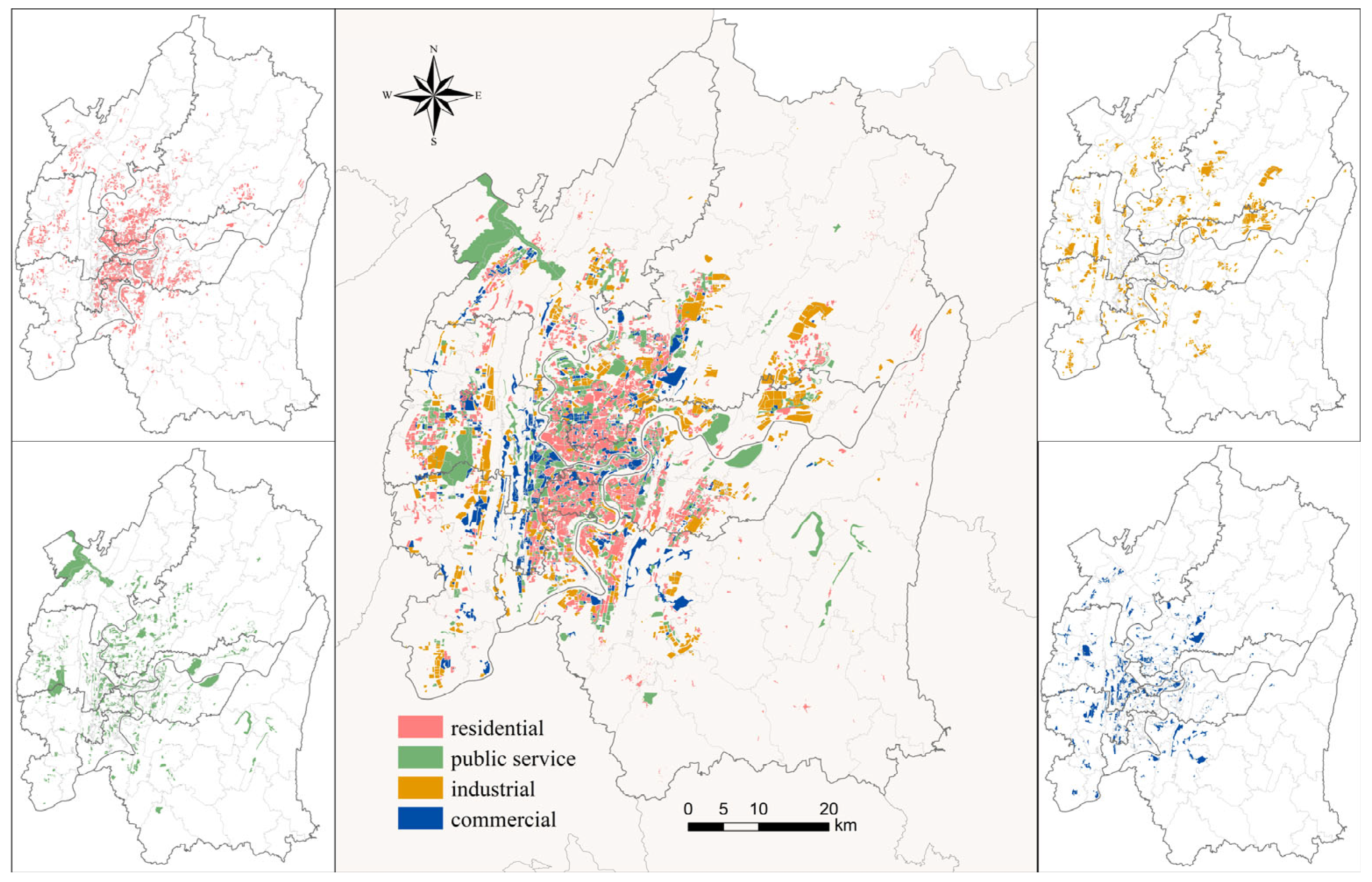
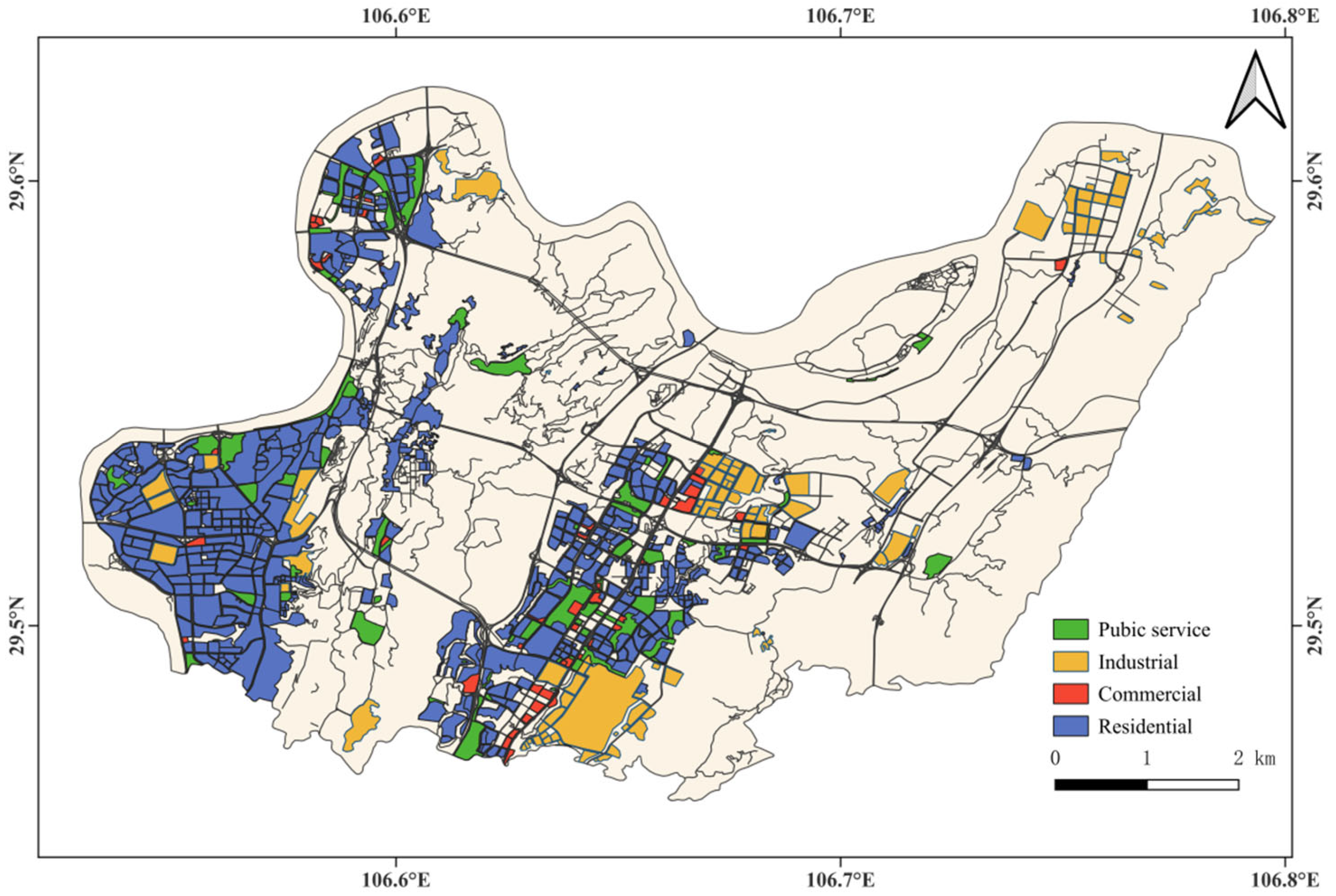


| UFZ Categories | Descriptions |
|---|---|
| Residential zones | An area used for living, including high-rise housing, residential areas, villas, etc. |
| Commercial zones | Commercial activities, including restaurants, shopping centers and office buildings. |
| Industrial zones | Places used for industrial activities, including factories, warehouses and logistics centers. |
| Public service zones | Living places Public areas, including schools, hospitals, etc. |
| Land Use Categories | UFZ Categories |
|---|---|
| residential | residential |
| commercial, retail | commercial |
| industrial | industrial |
| park, recreation ground, nature reserve, cemetery | public service |
| military, meadow, quarry, grass, farmland, forest, scrub, orchard, allotments | non-urban function land |
| UFZ Categories | Commercial | Industrial | Public Service | Residential | Sample Count |
|---|---|---|---|---|---|
| Number of train set samples | 246 | 387 | 458 | 656 | 1747 |
| Number of test set samples | 61 | 97 | 115 | 164 | 437 |
| Sum | 307 | 484 | 573 | 820 | 2184 |
| Model | OA (%) | Kappa |
|---|---|---|
| ImgNet + POINet + TrajNet | 84.13 | 0.779 |
| ImgNet + POINet | 82.61 | 0.758 |
| ImgNet + TrajNet | 82.83 | 0.761 |
| POINet + TrajNet | 78.49 | 0.699 |
Disclaimer/Publisher’s Note: The statements, opinions and data contained in all publications are solely those of the individual author(s) and contributor(s) and not of MDPI and/or the editor(s). MDPI and/or the editor(s) disclaim responsibility for any injury to people or property resulting from any ideas, methods, instructions or products referred to in the content. |
© 2025 by the authors. Licensee MDPI, Basel, Switzerland. This article is an open access article distributed under the terms and conditions of the Creative Commons Attribution (CC BY) license (https://creativecommons.org/licenses/by/4.0/).
Share and Cite
Zhang, Y.; Xu, Y.; Gao, J.; Zhao, Z.; Sun, J.; Mu, F. Urban Functional Zone Identification Based on Multimodal Data Fusion: A Case Study of Chongqing’s Central Urban Area. Remote Sens. 2025, 17, 990. https://doi.org/10.3390/rs17060990
Zhang Y, Xu Y, Gao J, Zhao Z, Sun J, Mu F. Urban Functional Zone Identification Based on Multimodal Data Fusion: A Case Study of Chongqing’s Central Urban Area. Remote Sensing. 2025; 17(6):990. https://doi.org/10.3390/rs17060990
Chicago/Turabian StyleZhang, Yongchuan, Yuhong Xu, Jie Gao, Zunya Zhao, Jing Sun, and Fengyun Mu. 2025. "Urban Functional Zone Identification Based on Multimodal Data Fusion: A Case Study of Chongqing’s Central Urban Area" Remote Sensing 17, no. 6: 990. https://doi.org/10.3390/rs17060990
APA StyleZhang, Y., Xu, Y., Gao, J., Zhao, Z., Sun, J., & Mu, F. (2025). Urban Functional Zone Identification Based on Multimodal Data Fusion: A Case Study of Chongqing’s Central Urban Area. Remote Sensing, 17(6), 990. https://doi.org/10.3390/rs17060990







